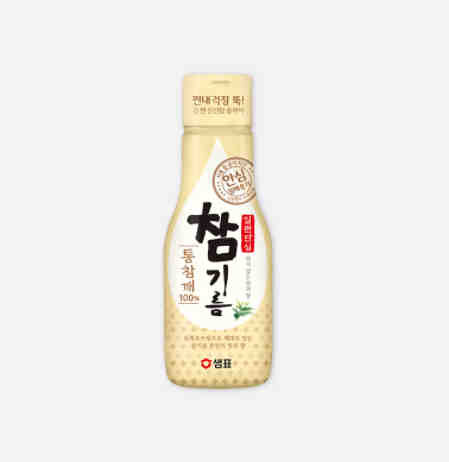Dark Toasted Sesame Oil
chamgireum.
“ CHAHM - GHEE - RUM ”
Ah, Korea’s olive oil. The finishing touch that adds a special glimmer to any dish.
Love it or hate it: It’s got a strong scent that won’t be denied. What can I tell you? You can cook Korean food without it, but it just won’t be the same. I would either put minimal amounts until you develop a taste for it or omit it completely. Korean cuisine and sesame oil go together like love and marriage (please let me know of a better metaphor).
There is one Korean sesame oil sommelier (there are over 1000 olive oil sommeliers to compare) and he’s opened up a sesame oil cafe in Korea. Check out the interesting article about it here.
You’ll find that if the recipe itself doesn’t include it, it will be used as a finishing touch. Drizzling sesame oil is a pretty liberal practice.
You may see toasted or raw (untoasted) sesame oil at the regular grocery store. Korean recipes are referring to the toasted kind. Toasty = savoury = delicious. The use of the raw oil (much lighter in colour) is a relatively new, health-conscious phenomenon. Raw sesame oil is quite odourless, which actually makes it suitable to use as an everyday multi-purpose oil however it won’t really work to get the traditional flavours of Korean recipes.
Sesame oil is known to be very healthy. Full of good unsaturated fatty acids, namely omega-6, which may prevent heart disease. It contains antioxidants as well as anti-bacterial and anti-inflammatory properties.
Not to mention how good it is for hair and skin. Sesame oil is often used as a hair oil as it’s believed to prevent premature grays and promote hair growth. A spoonful is said to help with constipation. Obviously, for these kinds of uses, the raw oil would be more appropriate. See sesame oil for health and beauty.
I can’t imagine putting toasted sesame oil in my hair. There was once a story (urban legend?) that was told to horrified reactions about a friend of a friend of a friend who was trying to bring back sesame oil from Korea and the bottle (this must be made up- why was it not packed properly if they had to bring it in a glass bottle) shattered at the airport and the stink was unbelievable. Cue national embarrassment.
qualities of toasted sesame oil
Is it made with whole sesame seeds or ground sesame powder?
Where are the sesame seeds from?
Is it pressed oil or has it been processed to death by other means?
Have the sesame seeds been pressed once (rich) or pressed multiple times?
Like how budget soy sauces will use soybean meal/powder rather than whole soybeans, unfortunately this is a way companies reduce costs. Importing sesame seeds whole to Korea imposes a lot of tax while importing the powder will lower the costs substantially. However, once the seeds are ground up, the surface area exposed to air is increased (potential rancidity) and the freshness and flavour are reduced.
Undoubtedly, using Korean sesame seeds grown locally will be the freshest. But labour costs being much higher in Korea, food products made with local ingredients will usually carry a heavy price tag.
Sesame seeds are ideally extracted manually. By either pressing down to squeeze or screwing down to expel the oil. Cheaper oils may use the hexane (chemical gasoline component) method to chemically separate the oil from powder. Supercritical fluid extraction is a relatively new method that is considered better than using hexane but still inferior compared to mechanically pressing.
Sesame seeds may contain over 50% oil content (source) and can be extracted more than once. As you may have guessed, the first press will expel the richest oil and be considerably thinned out with subsequent processing.
Back to Korean cooking, keep in mind that toasted sesame oil has a pretty low smoke point. This is why although sesame oil is used very much in Korean dishes, it’s usually not cooked in it. In most cases, it will be to drizzle or to use as part of a dressing or as a dip. Bibimbap? Drizzle sesame oil at the end. Salad dressing? Equal parts soy sauce, rice vinegar and sugar with a bit of sesame oil. Korean BBQ? Add salt and pepper to a dip dish and fill that sucker up with a small lake of sesame oil. Dunk meat pieces and enjoy hot, glistening protein goodness.
Be wary of a really good bargain on sesame oil. This is a seed oil and rather expensive. Some are made with pre-ground sesame powder rather than whole sesame seeds. For example, Ottogi has two variations with the one called Traditional Sesame Oil being half the price because it is made with seed powder. Ottogi Savoury Sesame Oil seems to be made with whole sesame seeds. Don’t worry, they only have the latter (that I can find) on Amazon.
best toasted sesame oil brands
We are lucky (I guess) in North America that we don’t get all the choices in toasted sesame oils actually available in Korea. It would be very confusing indeed. There are many, many types, brands and price points.
There was a law passed in recent years that prohibits the use of the term 참기름 (Sesame Seed Oil) if it’s not a wholly sesame seed product; There had been instances of toasted sesame oils being mixed with cheaper vegetable oils. These are still sold with a very budget-friendly price tag but are categorized as “flavoured oils”.
Also, without closely examining the ingredients list (which is difficult for us as the English translation may miss pertinent facts or omit them completely), it’s difficult to tell the method of processing, the origin of seeds and whether it is a whole or ground ingredient.
OTTOGI is Korea’s representative company selling sesame oil but the only one that uses whole sesame seeds is the one called 고소한 참기름. It is pictured below.
Ottogi Toasted Sesame Oil: Manufactured by one of the biggest food companies in Korea and the trusted brand for toasted sesame oil for most Korean households. They use imported sesame seeds (usually less flavourful than Korean seeds but probably a negligible difference most won’t be able to tell). This particular product in their lineup (bottle or can) is the one that utilizes 100% whole sesame seeds.
Cook’s Illustrated did a roundup of toasted sesame oils and Ottogi rated as the #1 all around favourite. Read their article here.
But to be honest, almost everyone I know uses KADOYA sesame oil. It is more easily found at most large (Asian or regular) grocery stores in North America.
Kadoya Toasted Sesame Oil: Japanese company making sesame oil since 1858.
I have some doubts about the preciseness of their ingredients list. It simply reads “sesame seed oil” but doesn’t specify whether they use whole or sesame seed powder. Also, they don’t state the origin of their primary ingredient. If someone reads Japanese or knows about their production methods, I’d really appreciate if you’d send me an email about it! I’ve learned to be suspicious of too-good-to-be-true and this one’s price seems too-good-to-be-true. Just wondering. There’s one in my kitchen cupboard right now.
(Edit: I’ve emailed the company and received a reply that verifies they use whole sesame seeds from mostly Africa, and they use an “expeller-press” method after roasting. Nice customer service :) )
Momofuku Toasted Sesame Oil: One of my favourite celebrity chefs (David Chang is Korean woot!) has released his own brand of toasted sesame oil. The hipster price tag is high. It’s marketed as cold-pressed but doesn’t specify whether they use whole sesame seeds or powder- I’m hoping my fave celebrity chef won’t let me down with inferior ingredients (have emailed the company, we’ll see).
(Edit: Still have not received a reply to my email. Kadoya responded that they roast and steam their seeds and so it is not “cold” pressed. I’m wondering how Momofuku is toasting their seeds and still is able to “cold” press them. Not sure who to ask, let me know if you have any ideas!)
Sempio Toasted Sesame Oil: Sempio, Korean Soy Sauce King, has come out with their own sesame oil made from 100% whole sesame seeds. I haven’t found it online (yet) but if you see it at the store, it may be worth a try.
Another point to keep in mind is that sesame oils used in restaurants will most often be the lowest quality type. It will pack a punch in that toasty, savoury flavour (aided by processing and additives) profile that may be difficult to imitate at home with quality ingredients.
Sesame oil is believed to be a core ingredient that can be beneficial to your health. We are probably ingesting all sorts of chemically-processed sauces when we eat out, so it’s worth putting in some effort to find a higher quality oil for home-cooking.
JEOLLANAMDO Premium Toasted Sesame Oil + Perilla Oil Gift Set: Pressed oils made with 100% whole seeds, locally grown in Korea. The sticker shock is shocking, so save this one as a buy for that someone special.
Toasted sesame oil can be stored in a cool, dark place for as long as a year (or longer to be honest with you). It’s sometimes suggested to be kept in the fridge and if you keep your olive oil in the fridge you may want to. However, I don’t know anyone that does this. Just a note that perilla oil is a bit different and is best consumed in a few months.
If you do love it, you can add a bit of this to almost everything. It adds an appealing shine with a tasty nutty flavor. You’ll find even picky toddlers will gobble up foods mixed with this.
BONUS RECIPE: Mix hot rice with a bit of soy sauce and sesame oil. Add fried egg if you’re feeling it. Classic hangry recipe that makes kids happy too.
You may also be interested in: How to Store Korean Ingredients

















